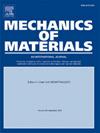A long short-term memory-based constitutive modeling framework for capturing strain path dependence in plastic deformation
IF 3.4
3区 材料科学
Q2 MATERIALS SCIENCE, MULTIDISCIPLINARY
引用次数: 0
Abstract
Macroscopic models struggle to capture the strain path-dependent behavior of metallic materials, particularly under random loading conditions. While crystal plasticity models effectively describe complex strain path dependence due to their physical basis, they suffer from significant computational inefficiencies and limited scalability. To address these challenges, this study introduces an LSTM-based constitutive modeling framework, a novel data-driven approach. The framework starts with fundamental experiments, optimized using a BPNN method to derive constitutive parameters for a crystal plasticity model. An extensive dataset is generated by simulating crystal plasticity along various random strain paths, which is used to train the LSTM network. The resulting model demonstrates exceptional computational efficiency, providing predictions in under 5 s—far faster than the 30-min crystal plasticity simulations. The LSTM-based model accurately predicts responses for strain paths outside the training dataset, exhibiting low RMSE and MAE values. Experimental results from six strain paths confirm the model's accuracy, capturing behaviors such as the Bauschinger effect and orthogonal hardening/softening. This framework offers a promising alternative to traditional constitutive models, extending crystal plasticity to macroscopic processes and enabling precise engineering predictions. The framework is also adaptable to other materials and holds potential for solving time-series related challenges.
基于长短期记忆的塑性变形应变路径依赖本构建模框架
宏观模型难以捕捉金属材料的应变路径依赖行为,特别是在随机加载条件下。晶体塑性模型由于其物理基础而有效地描述了复杂的应变路径依赖关系,但存在显著的计算效率低下和可扩展性限制。为了应对这些挑战,本研究引入了一种基于lstm的本构建模框架,这是一种新颖的数据驱动方法。该框架从基础实验开始,使用bp神经网络方法进行优化,以获得晶体塑性模型的本构参数。通过模拟晶体沿各种随机应变路径的塑性,生成一个广泛的数据集,用于训练LSTM网络。由此产生的模型显示出卓越的计算效率,在5秒内提供预测,远远快于30分钟的晶体塑性模拟。基于lstm的模型准确预测了训练数据集之外应变路径的响应,显示出较低的RMSE和MAE值。六种应变路径的实验结果证实了该模型的准确性,并捕获了鲍辛格效应和正交硬化/软化等行为。该框架为传统的本构模型提供了一个有希望的替代方案,将晶体塑性扩展到宏观过程并实现精确的工程预测。该框架也适用于其他材料,并具有解决时间序列相关挑战的潜力。
本文章由计算机程序翻译,如有差异,请以英文原文为准。
求助全文
约1分钟内获得全文
求助全文
来源期刊

Mechanics of Materials
工程技术-材料科学:综合
CiteScore
7.60
自引率
5.10%
发文量
243
审稿时长
46 days
期刊介绍:
Mechanics of Materials is a forum for original scientific research on the flow, fracture, and general constitutive behavior of geophysical, geotechnical and technological materials, with balanced coverage of advanced technological and natural materials, with balanced coverage of theoretical, experimental, and field investigations. Of special concern are macroscopic predictions based on microscopic models, identification of microscopic structures from limited overall macroscopic data, experimental and field results that lead to fundamental understanding of the behavior of materials, and coordinated experimental and analytical investigations that culminate in theories with predictive quality.
 求助内容:
求助内容: 应助结果提醒方式:
应助结果提醒方式:


